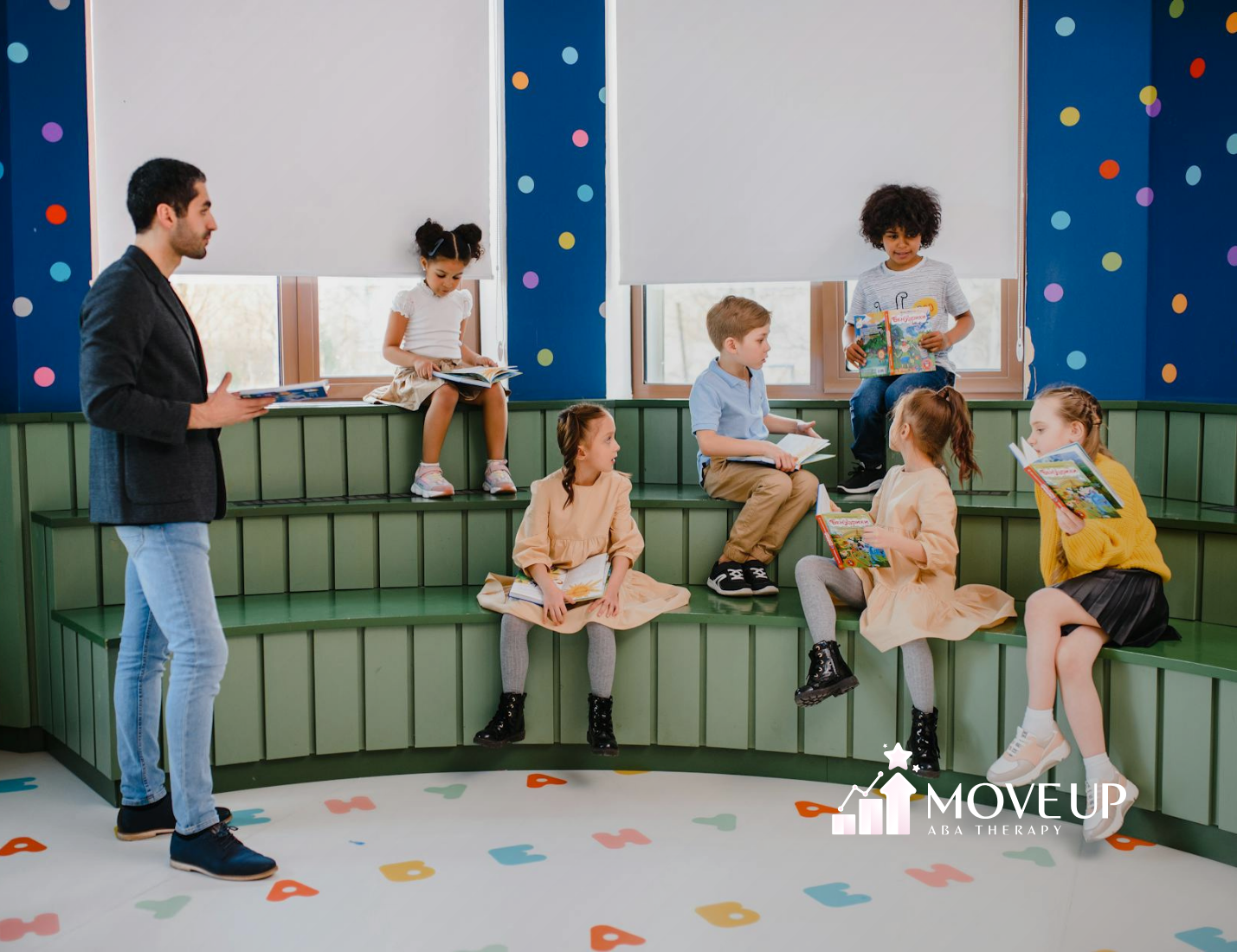Understanding ABA Therapy
Applied Behavior Analysis (ABA) therapy is a research-backed approach for autism intervention with over 50 years of proven effectiveness in promoting positive developmental outcomes. Understanding the basics and the importance of early intervention can empower parents and educators to make informed decisions about school-based autism therapy.
Basics of ABA Therapy
ABA therapy focuses on improving specific behaviors such as communication, social skills, and adaptive learning skills (e.g., fine motor dexterity, hygiene). It uses a range of techniques and principles to bring about meaningful and positive changes in behavior. Key components include:
- Discrete Trial Training (DTT): Breaks down skills into small, teachable components.
- Natural Environment Training (NET): Incorporates learning opportunities in natural settings.
- Pivotal Response Training (PRT): Targets pivotal areas of a child’s development.
The goal of ABA is to increase behaviors that are helpful and decrease behaviors that are harmful or affect learning.
Importance of Early Intervention
Early detection of developmental delays related to autism can begin as early as 18 months, providing an opportunity for early intervention that can make a life-changing difference for children. Specifically:
- Foundational Skills: ABA therapy equips children with essential skills needed for success in a classroom environment, such as communicating needs, behavioral self-regulation, sitting in a group, participating in class activities, and managing transitions between different tasks.
- Impact Over Time: Early intervention can significantly enhance the child’s ability to develop important functional skills, leading to better long-term outcomes.
By addressing these foundational skills in the early stages, children are better prepared to transition into the school environment. Effective ABA therapy often involves collaboration with parents, educators, and therapists to ensure that the skills learned can be generalized across different settings.
Early intervention is crucial for maximizing the effectiveness of school-based ABA interventions. The collaborative approach in school settings ensures a tailored strategy to meet each child’s unique needs, promoting a supportive and consistent learning environment. For educators and families seeking more information on effective implementation, check out our guide on school-based behavior therapy.
School-Based ABA Therapy Overview
Applied Behavior Analysis (ABA) therapy in educational settings is pivotal for supporting students with Autism Spectrum Disorder (ASD). Integrating ABA into school programs ensures that children can benefit from a structured, supportive environment conducive to learning and social interaction.
School Programs for Children with Autism
School programs designed for children with autism emphasize incorporating ABA principles to enhance learning experiences. By addressing foundational skills early on, students are better equipped to navigate the classroom environment and interact with peers.
These programs often include:
- Individualized Education Plans (IEPs): Tailored to meet the specific needs of each child, IEPs include ABA strategies to target goals like communication, social skills, and academic performance.
- Inclusive Classrooms: Integrating students with autism into mainstream classrooms encourages social integration and peer learning. Opportunities for social interaction foster community integration and enhance group dynamics.
- Ancillary Services: Schools offer access to speech therapy, occupational therapy, and other support services that complement ABA interventions, promoting a holistic approach to a child’s development.
Individualized ABA Therapy Options
Personalized ABA therapy within schools is designed to cater to the unique needs of each child, adapting strategies to improve critical skills such as communication, attention, and social interactions.
| Key Skill Areas Targeted | Description |
| Communication | Enhancing verbal and non-verbal communication skills. |
| Social Skills | Teaching appropriate social behavior and interactions. |
| Academic Skills | Supporting learning in subjects like math, reading, and writing. |
| Behavioral Regulation | Developing self-control and adaptive behaviors. |
Studies show that ABA therapy, when implemented for 25 to 40 hours per week over one to three years, significantly benefits individuals across the autism spectrum.
Examples of Individualized ABA Therapy Techniques:
- Discrete Trial Training (DTT): Breaking down skills into small, teachable components.
- Natural Environment Training (NET): Enhancing learning in natural settings, such as the classroom or playground, to promote generalization of skills.
- Task Analysis: Teaching complex tasks by breaking them down into smaller, manageable steps.
Implementing ABA interventions in schools provides students with the necessary tools to enhance their overall experience and success.
Role of ABA Therapy in School
Benefits of ABA Therapy in a School Setting
Applied Behavior Analysis (ABA) therapy offers several benefits when integrated into the school setting. ABA therapy focuses on understanding and modifying behavior through manageably achievable steps, primarily employing methods based on positive reinforcement. This proven evidence-based approach has been effective in improving behavior, communication, and social interactions for individuals with autism and other neurodevelopmental conditions.
One of the primary benefits of ABA therapy in schools is the personalized nature of the interventions. By tailoring the therapy to address the unique needs of each student, ABA allows for more effective skill development that might not be readily available in general education classrooms or public schools. This personalized approach can significantly improve the child’s ability to function independently and participate more effectively in daily school life.
Additionally, ABA therapy in schools can promote smoother transitions for students by equipping them with essential classroom skills prior to starting school. These foundational skills include communicating needs, behavioral self-regulation, sitting in a group, participating in class activities, and managing transitions between tasks.
Tailored Support in School Programs
Tailored support within school programs is crucial for the success of students with autism. High-leverage practices (HLPs) that can be used with students with Autism Spectrum Disorder (ASD) include small-group instruction, functional behavior assessments, peer-assisted strategies, and organized and supportive learning environments. These practices, often overlapping with evidence-based practices (EBPs) for students with autism, can provide structured and supportive contexts for learning.
ABA therapy before starting school can help address behaviors and skills that are essential for classroom success. By focusing on critical developmental areas such as behavioral self-regulation, appropriate social interactions, and functional communication, ABA therapy facilitates a supportive transition to the school environment.
| ABA Therapy Intervention | Benefit in School Setting |
| Communicating Needs | Helps students convey their needs effectively, reducing frustration |
| Behavioral Self-Regulation | Enables students to manage their behaviors, promoting classroom harmony |
| Participating in Class Activities | Encourages active engagement in learning, enhancing educational outcomes |
| Managing Transitions | Eases movement between tasks, increasing focus and reducing disruptions |
Integrating ABA therapy within school programs ensures that students with autism receive the tailored support they need to thrive academically and socially. For more information on ABA therapy techniques utilized in schools, visit our page on school-based ABA techniques. This comprehensive approach underscores the vital role that ABA therapy plays in fostering a productive and inclusive educational experience for children with autism.
Effective Therapies for Autism
Selecting the right therapies for children with autism is essential for supporting their development and helping them thrive in a school environment. This section will explore three key therapies: communication interventions, social skills therapy, and behavioral therapy.
Communication Interventions
Communication interventions in autism therapy aim to help children with ASD understand the nuances of language, express themselves effectively, and use language skills appropriately in various contexts. Programs such as speech therapy at Spero Academy work on enhancing language comprehension and expression. By focusing on these areas, communication interventions equip individuals with ASD with the necessary skills to understand and share their thoughts and needs clearly.
| Communication Goals | Strategies |
| Understanding Language | Visual aids, repetition |
| Expressing Themselves | Speech therapy, role-playing |
| Context-Appropriate Language Use | Social stories, practice scenarios |
Social Skills Therapy
Social skills therapy focuses on building confidence and competence in various social settings for children with autism. This type of therapy integrates social development into all activities, helping children function effectively and confidently in social interactions. Programs at Spero Academy emphasize this integration, aiming to enhance the social competencies of children with ASD.
| Social Skills Goals | Strategies |
| Confidence in Social Settings | Group activities, peer modeling |
| Effective Interaction | Social stories, guided interactions |
| Understanding Social Cues | Explicit teaching, visual supports |
Behavioral Therapy
Behavioral therapy is a crucial component of the autism intervention landscape. It helps children with ASD manage behaviors such as repetitive movements, attention difficulties, and expressing frustration appropriately. By focusing on these aspects, behavioral therapy aims to achieve greater stability both in the classroom and at home. ABA (Applied Behavior Analysis) therapy is a well-researched approach that uses positive reinforcement to understand and modify behavior.
| Behavioral Goals | Strategies |
| Reduce Repetitive Movements | Distraction techniques, redirection |
| Improve Attention | Structured activities, clear instructions |
| Manage Frustration | Coping strategies, positive reinforcement |
Each of these therapies is integral to a holistic approach to autism treatment and should be tailored to the individual needs of the child. Implementing these therapies effectively within a school setting can significantly enhance the educational and social experiences of children with autism.
Implementing ABA Therapy in Schools
When it comes to implementing Applied Behavior Analysis (ABA) therapy in school settings, collaboration and personalizing interventions are critical. This section delves into effective strategies to integrate ABA therapy within educational institutions to support children with Autism Spectrum Disorder (ASD).
Collaborative Approach in School Settings
A collaborative approach brings together educators, therapists, parents, and support staff to create a cohesive plan tailored to the child’s needs. This collaboration ensures that each team member understands the goals and strategies of the ABA program, creating a unified front to support the student’s development.
Benefits of Collaboration
- Enhanced Communication: Regular meetings and updates among team members foster transparent communication and timely adjustments to intervention plans.
- Resource Sharing: Schools provide access to a range of resources such as speech and occupational therapy, which can work in tandem with ABA therapy.
- Consistent Support: Integration of ABA strategies within the classroom setting ensures consistent support throughout the school day.
Personalized Interventions for Success
Personalized ABA interventions are designed to address the specific challenges faced by each student with autism. These interventions aim at fostering academic success, improving overall behaviors, developing social skills, and promoting independence.
Key Components of Personalized Interventions
- Individualized Behavior Plans (BIPs): Based on Functional Behavior Assessments (FBAs), these plans tailor interventions to the student’s unique behavioral needs.
- Skill Building: Focused on enhancing communication, social interaction, and daily living skills essential for academic and personal growth.
- Contextual Adaptation: Customize interventions to align with the students’ environment, whether in a general education classroom or specialized settings.
| Intervention Type | Key Focus Areas |
| Behavior Plans | Managing specific behaviors |
| Skill Building | Communication, Social Skills, Daily Living |
| Adaptation | Tailoring to specific classroom environments |
By taking a collaborative approach and implementing personalized interventions, school-based ABA therapy can provide substantial benefits for children with autism. This integration helps create a nurturing environment that supports their comprehensive development and long-term success.
IEP Goals for Children with Autism
IEPs, or Individualized Education Programs, are designed to support the growth and development of children with autism, addressing their unique strengths and challenges. Legal requirements by the Individuals with Disabilities Education Act (IDEA) ensure that IEPs are tailored to meet the specific needs of each student.
Key Areas of IEP Goals
For children with autism, key areas of IEP goals span various aspects of development, from communication to behavior.
| Key Area | Examples of Goals |
| Communication | Improving expression, understanding, and meaningful conversations |
| Social Skills | Enhancing appropriate behaviors, social navigation, and relationship-building |
| Academic | Developing abilities in reading, writing, math, and problem-solving |
| Behavior | Reducing challenging behaviors and promoting positive ones |
These goals are crucial for supporting the overall development and success of students with autism.
Strategies for Implementing IEP Goals
Effectively implementing IEP goals requires a collaborative and strategic approach.
| Strategy | Description |
| Individualized Instruction and Accommodations | Tailoring teaching methods, materials, and environments to meet each student’s needs |
| Data Collection and Progress Monitoring | Tracking performance and determining the effectiveness of interventions |
| Collaboration and Communication with the IEP Team | Ensuring a consistent and supportive approach in addressing the student’s needs |
For successful outcomes, it’s essential to involve a team, including parents, educators, and professionals who work together to develop and review goals tailored to the child’s needs. Goals must be individualized and measurable, with clear criteria for success. Regular review and evaluation of the goals ensure their ongoing effectiveness.
By prioritizing these strategies, parents and educators can ensure that IEP goals are effectively implemented, leading to improved outcomes and a more supportive educational environment for children with autism.
SOURCES:
https://www.spero.academy/parent-essentials/blog/1614842/goals-for-children-with-autism
https://iris.peabody.vanderbilt.edu/module/asd2/cresource/q1/p02/
https://pmc.ncbi.nlm.nih.gov/articles/PMC10918025/
https://www.ablespace.io/blog/iep-goal-examples-for-students-with-autism/
https://www.nichd.nih.gov/health/topics/autism/conditioninfo/treatments







